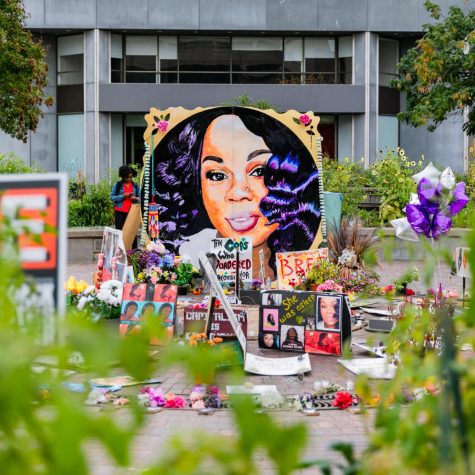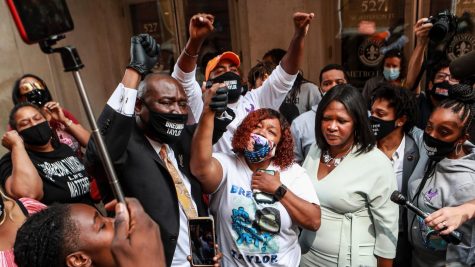Breonna Taylor: Facts From Faux
Everything You Need To Know About The Breonna Taylor Case
Seven months later after the Breonna Taylor shooting, on October 8, 2020, Louisville Police released body camera footage from the officers that barged into Taylor’s apartment. The footage revealed the true disorganization and chaos of that night, and allowed for more truth to become apparent. Ever since that night, the media went crazy trying to cover what really happened that night in Taylor’s apartment. The lines between fact and opinion began to blur with articles and reposts on our Instagram feeds. The part of the media that treated the entire BLM movement as a trend saw Taylor as another flashy trending story, instead of important news that should not be reported biasly or swung in any direction but an authentic one.
“Some bias I see blurring the lines of truth and false are that each side of politics is either trying to downplay or up play the situation. People are changing the story to fit their beliefs and now there are millions of different versions. Some don’t want to accept what actually happened, and because of this, it is now really hard to separate the conspiracies from the fact,” says Skylar Daveline ‘23.

March 13, 2020 marks the shooting and death of Breonna Taylor. Officers had a warrant to search her home because of a narcotic investigation that regarded Taylor’s on and off ex-boyfriend, Jamarcus Glover. Despite Glover confirming he had not been in contact with Taylor for at least 2 months, police claim he used her address to receive suspicious packages.
LMPD received an approved “no knock” warrant to search Taylor’s home. A “no-knock” warrant does not require police to follow the “knock and announce” rule when attempting to search a place, meaning they do not have to state the usual, “This is the police. We are executing a warrant,” which is in place to allow an ample amount of time for those on the other side of the door to acknowledge and recognize that law enforcement seeks to enter.
The law enforcement involved in the raid of Taylor’s home claimed they did knock and announce despite the type of warrant; however, it has been confirmed they loudly banged on the door and only one 1 out of 11 neighbors heard one announcement of identification as police. If all the police did was cause a 35-40 second ruckus by knocking, but did not make themselves known as officers, the whole purpose of the “knock and announce” rule was defeated. Even though the “knock and announce” was executed incorrectly and unlawfully, the warrant for Breonna Taylor was “no knock.”.
Although the point of a “no knock” warrant is to preserve evidence and prevent any tainting of it by catching suspects off guard, this only made Taylor’s boyfriend, Kenneth Walker III who was with her at the time of the raid, feel threatened. Walker later tells police that he believed it was a home invasion and/or Glover trying to break in.
Woken up from his sleep past midnight by harsh banging on his girlfriend’s apartment door, alerted and afraid, Walker picked up a legally owned and licensed firearm to defend himself and Taylor. When the hinges broke off their door, Walker fired a single shot into Sergeant Mattingly’s leg as he entered the apartment. In response, at least six rounds were shot towards Taylor’s home, including the infamous one fired by Brett Hankinson.
Albeit of his blocked view, Hankinson shot into the sliding glass door and window of Taylor’s apartment patio, violating a department policy that requires officers to have a clear line of sight. He, however, is not directly charged with the murderer of Taylor, nor are the other officers involved. Because bullets of Hankinson’s gun did not match the one that struck and ultimately caused Breonna Taylor’s death, he was only charged with wanton endangerment for potentially harming Taylor’s apartment neighbors.
Kentucky Attorney General Daniel Cameron suggested that the entire situation was a tragedy where there is no one to blame, but it has become evident that Cameron himself was selective towards what information was released to the public in an attempt to mislead them about key facts in the case. To this day, none of the officers involved at the scene are charged for the death of Breonna Taylor and The Washington Post declares, “The police work in this case was sloppy, and the warrant services was reckless. Taylor is dead because of a cascade of errors, bad judgement and a dereliction of duty. And it’s important that the record on this be clear.”

Since the national attention of the case beginning in May, however, Louisville officials agreed to pay a $12 million settlement for a wrongful-death lawsuit to reforms in place to prevent any future deaths by officers. Louisville officials also banned the use of no-knock warrants with encouragement of cases like Taylor’s and because of the recent police brutality and systemic racism movements.
The investigation for Breonna Taylor’s case is still open, but progress is incredibly slow. As of now, the FBI and the internal probes are unsure if any more charges could be arraigned. Currently, in spite of the uncertainty, the Taylor family is seeking that the grand jury transcripts are released and the LMPD is being sued by Walker. Both of which, if accomplished, can and will paint a clearer picture to exactly what the officers did that tragic night.
